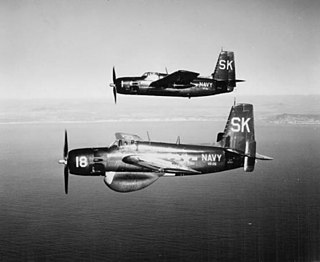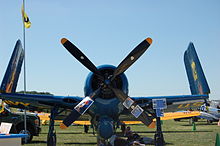
The Vought F4U Corsair is an American fighter aircraft that saw service primarily in World War II and the Korean War. Designed and initially manufactured by Chance Vought, the Corsair was soon in great demand; additional production contracts were given to Goodyear, whose Corsairs were designated FG, and Brewster, designated F3A.

The McDonnell FH Phantom is a twinjet, straight-wing, carrier-based fighter aircraft designed and first flown during late World War II for the United States Navy. As a first-generation jet fighter, the Phantom was the first purely jet-powered aircraft to land on an American aircraft carrier and the first jet deployed by the United States Marine Corps. Although only 62 FH-1s were built it helped prove the viability of carrier-based jet fighters. As McDonnell's first successful fighter, it led to the development of the follow-on F2H Banshee, which was one of the two most important naval jet fighters of the Korean War; combined, the two established McDonnell as an important supplier of navy aircraft.

The North American FJ-2 and FJ-3 Fury are a series of swept-wing and carrier-capable fighters for the United States Navy and Marine Corps. The FJ-2 resulted from an effort to navalize the North American F-86 Sabre operated by the United States Air Force. These aircraft feature folding wings, and a longer nose landing strut designed to increase angle of attack upon launch and to accommodate a longer oleo to absorb the shock of hard landings on an aircraft carrier deck.

The Grumman E-1 Tracer was the first purpose-built airborne early warning aircraft used by the United States Navy. It was a derivative of the Grumman C-1 Trader and entered service in 1958. It was replaced by the more modern Grumman E-2 Hawkeye by the 1970s.

The Grumman F9F Panther is an early carrier-based jet fighter designed and produced by the American aircraft manufacturer Grumman. It was the first jet-powered fighter aircraft to see air-to-air combat with the United States Navy as well as being Grumman’s first jet fighter.

The Douglas SBD Dauntless is a World War II American naval scout plane and dive bomber that was manufactured by Douglas Aircraft from 1940 through 1944. The SBD was the United States Navy's main carrier-based scout/dive bomber from mid-1940 through mid-1944. The SBD was also flown by the United States Marine Corps, both from land air bases and aircraft carriers. The SBD is best remembered as the bomber that delivered the fatal blows to the Japanese carriers at the Battle of Midway in June 1942. The type earned its nickname "Slow But Deadly" during this period, along with a rarely-used accompanying nickname of "Furious D."

The Grumman F4F Wildcat is an American carrier-based fighter aircraft that entered service in 1940 with the United States Navy, and the British Royal Navy where it was initially known as the Martlet. First used by the British in the North Atlantic, the Wildcat was the only effective fighter available to the United States Navy and Marine Corps in the Pacific Theater during the early part of the Second World War. The disappointing Brewster Buffalo was withdrawn in favor of the Wildcat and replaced as aircraft became available.

The Grumman C-1 Trader is a carrier onboard delivery (COD) variant of the Grumman S-2 Tracker. It was replaced by a similar version of the Northrop Grumman E-2 Hawkeye, the Grumman C-2 Greyhound.

The Grumman F6F Hellcat is an American carrier-based fighter aircraft of World War II. Designed to replace the earlier F4F Wildcat and to counter the Japanese Mitsubishi A6M Zero, it was the United States Navy's dominant fighter in the second half of the Pacific War. In gaining that role, it prevailed over its faster competitor, the Vought F4U Corsair, which initially had problems with visibility and carrier landings.

The Grumman F7F Tigercat is a heavy fighter aircraft that served with the United States Navy (USN) and United States Marine Corps (USMC) from late in World War II until 1954. It was the first twin-engine fighter to be deployed by the USN. While the Tigercat was delivered too late to see combat in World War II, it saw action as a night fighter and attack aircraft during the Korean War.

The Kawanishi N1K was an Imperial Japanese Navy fighter aircraft, developed in two forms: the N1K Kyōfū, a floatplane designed to support forward offensive operations where no airstrips were available, and the N1K-J Shiden, a land-based version of the N1K. The N1K-J was considered by both its pilots and opponents to be one of the finest land-based fighters flown by the Japanese during World War II.

The Mitsubishi A7MReppū was designed as the successor to the Imperial Japanese Navy's A6M Zero, with development beginning in 1942. Performance objectives were to achieve superior speed, climb, diving, and armament over the Zero, as well as better maneuverability – all parameters that were ultimately achieved towards the end of its development in 1945. However, limitations on Japanese industry towards the end of the war prevented the A7M from ever entering mass production or being deployed for active duty, and it never saw active service. Its Allied reporting name was "Sam".

The Lockheed Ventura is a twin-engine medium bomber and patrol bomber of World War II.

The Pratt & Whitney R-2800 Double Wasp is an American twin-row, 18-cylinder, air-cooled radial aircraft engine with a displacement of 2,800 cu in (46 L), and is part of the long-lived Wasp family of engines.

The Goodyear F2G Corsair, often referred to as the "Super Corsair", is a development by the Goodyear Aircraft Company of the Vought F4U Corsair fighter aircraft. The F2G was intended as a low-altitude interceptor and was equipped with a 28-cylinder, four-row Pratt & Whitney R-4360 air-cooled radial engine.

The Lockheed T2V SeaStar, later called the T-1 SeaStar, is a carrier-capable jet trainer for the United States Navy that entered service in May 1957. Developed from the Lockheed T-33, it was powered by one Allison J33 engine.

The Grumman AF Guardian is the first purpose-built anti-submarine warfare (ASW) carrier-based aircraft to enter service with the United States Navy. It consisted of two airframe variants, one for detection gear, the other for weapons. The Guardian remained in service until August 1955, when it was replaced by the twin-engined Grumman S-2 Tracker. The Guardian was the largest single-engine piston-powered carrier aircraft ever to see service.

The Grumman XTSF was a proposed twin-engine torpedo scout aircraft, designed by Grumman for the United States Navy towards the end of World War II. Based on the design of the Grumman F7F Tigercat fighter, but enlarged and with the addition of a bomb bay, the XTSF was deemed too large for carrier operations, and the project was cancelled before any aircraft were built. Instead, the Navy chose to order the single-engine XTB3F, which became the successful AF Guardian.




























